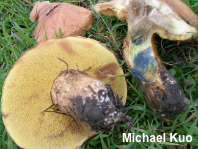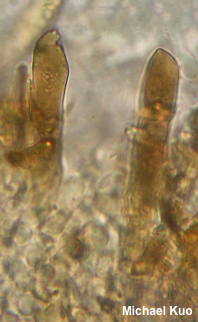| Major Groups > Boletes > Suillus > Suillus caerulescens |

|
Basidiomycota > Boletales > Suillaceae > Suillus . . . Suillus caerulescens by Michael Kuo, 22 January 2024 This western North American Suillus is a mycorrhizal associate of Douglas-fir, recognized by its blue-staining flesh and reddish brown staining pore surface, along with its yellowish to tawny cap and the presence of a ring on the stem. Two other western Suillus species, also associated with Douglas-fir, are very similar and should be compared carefully: Suillus lakei has a drier, more fibrillose and scaly cap, along with flesh in the stem base that does not stain as prominently blue as that of Suillus caerulescens. Additionally, Suillus lakei has a wider range than Suillus caerulescens, appearing throughout the natural range of Douglas-fir; Suillus caerulescens appears to be limited to the Pacific Northwest and northern California. Suillus ponderosus is also similar, and is probably harder to separate from Suillus caerulescens than Suillus lakei, since its cap is also usually sticky when fresh and young. However, the blue staining is less notable, and a crucial morphological difference can be found in the ring on the stem, when young and fresh specimens are examined. The ring of Suillus ponderosus is gelatinous and reddish brown in young specimens, resulting in a reddish ring in older specimens; the ring of Suillus caerulescens is dry and whitish throughout development. A fourth similar species, Suillus imitatus, was described by Smith & Thiers (1964), and a variant (viridescens) was later described by Smith & Trappe (1972)—but these taxa turned out to represent Suillus caerulescens and Suillus ponderosus, respectively, when Nguyen and collaborators sequenced the type collections (2012). Description: Ecology: Mycorrhizal with Douglas-fir; growing alone or gregariously; fall and winter; originally described from Washington; distributed throughout the Pacific Northwest and northern California. The illustrated and described collection is from California. Cap: 5–15 cm across; convex becoming broadly convex or nearly flat; sticky to slimy when fresh and young; bald or with a few patches of appressed fibers or scales; yellowish brown to tawny brown; the margin initially inrolled, with a small extension of sterile tissue. Pore Surface: Bright yellow becoming dull yellow and eventually brownish; bruising slowly reddish brown; pores at maturity angular and radially arranged (but not boletinoid), about 1–2 mm across; tubes 5–10 mm deep. Stem: 4–9 cm long; 2–4 cm thick; more or less equal, or tapered in either direction; solid; often finely reticulate near the apex; bald or somewhat fibrillose, especially below; lacking glandular dots; yellow above, dingy yellowish to brownish below; sometimes bruising bluish or brownish; with a white, dry ring that soon collapses. Flesh: Pale yellow; staining blue in the stem base when exposed, elsewhere not staining, or staining pinkish to brownish. Odor and Taste: Odor fragrant; taste mild or slightly acidic. Chemical Reactions: Ammonia grayish on cap; pale grayish lilac on flesh. KOH olive gray becoming dark gray on cap; dark gray on flesh. Iron salts olive on cap; olive to bluish on flesh. Spore Print: Cinnamon brown. Microscopic Features: Spores 7–11 x 3–4 µm; boletoid-fusiform or occasionally elongated-ellipsoid; smooth; hyaline to yellowish in KOH. Basidia 25–32 x 3–5 µm; clavate; 4-sterigmate. Cystidia in bundles; often poorly defined individually; 25–75 x 5–10 µm; cylindric to subfusiform or subclavate; smooth; thin-walled; brown in KOH. Pileipellis an ixocutis; elements 2.5–5 µm wide, smooth, hyaline to brownish in KOH. REFERENCES: A. H. Smith & H. D. Thiers, 1964. (Smith & Thiers, 1964; Thiers, 1975; Thiers, 1979; Smith, Smith & Weber, 1981; Arora, 1986; Phillips, 1991/2005; Lincoff, 1992; Both, 1993; Bessette, Roody & Bessette, 2000; Trudell & Ammirati, 2009; Nguyen et al., 2012; Klofac, 2013; Desjardin, Wood & Stevens, 2015; Nguyen et al., 2016; Siegel & Schwarz, 2016; MacKinnon & Luther, 2021.) Herb. Kuo 01130517. This site contains no information about the edibility or toxicity of mushrooms. |
© MushroomExpert.Com |
|
Cite this page as: Kuo, M. (2022, September). Suillus caerulescens. Retrieved from the MushroomExpert.Com Web site: http://www.mushroomexpert.com/suillus_caerulescens.html |



